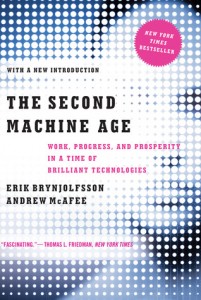 According to legend, John Henry was a steel-driving man who set out to challenge a new-fangled steam hammer to a steel driving contest. It did not end well for John, who died with his hammer in his hand. That was the first machine age.
According to legend, John Henry was a steel-driving man who set out to challenge a new-fangled steam hammer to a steel driving contest. It did not end well for John, who died with his hammer in his hand. That was the first machine age.
Replace John Henry with Jeopardy champions and the steam hammer with IBM’s Watson and you have an idea what the second machine age is about. To deepen your awareness and figure out what it means for you, read The Second Machine Age: Work, Progress, and Prosperity in a Time of Brilliant Technologies by Erik Brynjolfsson and Andrew McAfee. They don’t necessarily think you will go the way of John Henry.
The authors start with an overview of the Second Machine Age. They define three things that characterize the age.
Moore’s Law is the driver and that means exponential change and growth. We’re not used to that. We think arithmetically. But to understand what’s happening, you need to realize that change is happening faster than you ever imagined.
As more and more things become digitized they become subject to Moore’s Law. That means that changes in sensors and imaging and a host of other things begin to change faster, too.
The third important characteristic is what the authors call “Recombinant Growth.” They note that most innovation isn’t coming up with totally new things. Instead it involves combining things that already exist in new ways. All those fast changing digitized things are candidates for combining: an exponential increase in the number of building blocks you can make new things with.
Brynjolfsson and McAfee look at all this and draw three conclusions. In their words:
“The first is that we’re living in a time of astonishing progress with digital technologies— those that have computer hardware, software, and networks at their core.”
“Our second conclusion is that the transformations brought about by digital technology will be profoundly beneficial ones.”
“Our third conclusion is less optimistic: digitization is going to bring with it some thorny challenges.”
That’s the “What.” It makes the book worth reading. But what makes it really special is the “So hat” chapters, especially the ones that address those “thorny challenges.”
If you’re looking for clues to what all this change may mean for your career or your business, play close attention to the chapters on “bounty” and “spread.” “Bounty” is the amazing array of wonderful things that this digitization and development gives us. “Spread” is different. It’s about the gap between winners and everyone else.
As chapter ten puts it, the biggest winners will be stars and superstars. And everyone else?
“there’s never been a worse time to be a worker with only ‘ordinary’ skills and abilities to offer, because computers, robots, and other digital technologies are acquiring these skills and abilities at an extraordinary rate.”
So what, I hear you cry, should we do in the face of this? Start by avoiding the “computers or humans” dichotomy. Instead think about ways to arrange things so that humans and computers work in harmony. Beyond that, the authors have some specific advice.
“Our recommendations about how people can remain valuable knowledge workers in the new machine age are straightforward: work to improve the skills of ideation, large-frame pattern recognition, and complex communication instead of just the three Rs. And whenever possible, take advantage of self-organizing learning environments, which have a track record of developing these skills in people.”
Bottom Line
If you have read the authors’ earlier book, The Race Against the Machine, you’ll find a lot from that book recreated here, but with a more optimistic slant. Read the reviews and look inside the book to decide if this book is worth your time and money.
This will be a great book for you if you approach it as an idea starter. Look for clues you can combine with what you’re witnessing in your life and reading in other places to help create your unique ideas about how the world is changing and what it means for you.
This will not be a good book for you if you take it as the final word on technology or history or even the Second Machine Age. Part of what’s here will turn out to be wrong. Most of it will be partly right. And new insights and analysis will build on, refute, and modify the ideas here.
Free Video Summary
Get more of the big ideas from The Second Machine Age: Work, Progress, and Prosperity in a Time of Brilliant Technologies with a free 4-minute video summary. Click Here to get it now.


There are no comments yet, why not be the first to leave a comment?